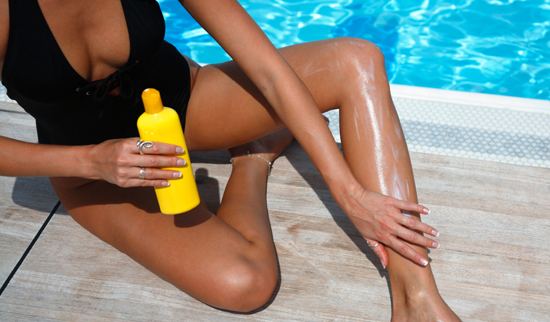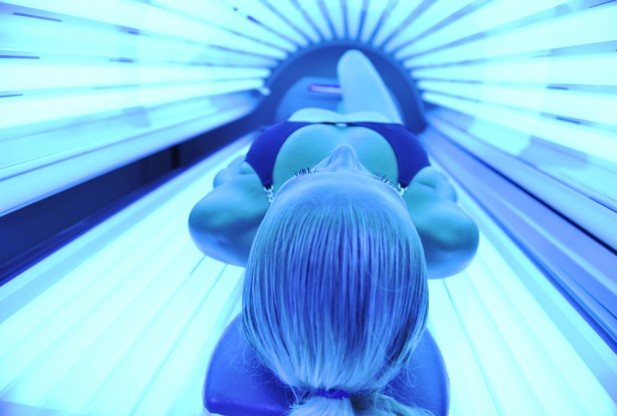
Generally speaking, a tan signifies the sun damage on the skin to some degree.
There was a time a tan signified wealth and health, but no longer! In fact, the deep, bronzed look is now “out”, and companies which once promoted agents to enhance a tan are now actively promoting sunscreens.
The Sun has many beneficial health effects, but only a moderate sun exposure is recommended.
However, there are tanning creams, accelerators and beds available in the market to help you satisfy the need for a tan.
If you are applying a broad spectrum sunscreen with a SPF of 15 regularly, you should get a minimal tan or no tan at all.
Tanning Creams
If your motive for getting a tan is to have a so-called healthier hue, there are products available which will color your skin to look as though it is tanned, for example, Clarin’s Self Tanning Milk, Estee Lauder Tanning Cream, and Lancôme Tanning Cream.
Tanning creams contain di-hydroxy acetone (DHA) which chemically reacts with the top layer of the skin to produce the appearance of a natural golden tan. This is a safe and effective way to achieve a summertime glow. After applying these creams, will take a couple of hours for color change to take place and it will last several days until the top layer of skin is gradually sloughed off. These products are much better than the skin colorants of the past which tended to streak the skin and stain clothing. Many tanning creams contain sunscreens and tanning accelerators, as well.
Some tanning agents, better termed coloring can be taken orally. These agents contain carotenoids ( cousins to carotene found in carrots ) which are deposited in the fat and reach the epidermis through the sweat pores thus giving a tanned appearance. Some of these agents, unfortunately, may give a tan like color that has an unnaturally orange hue. Because the skin is thicker on the palms of the hands and the soles of the feet, these areas become distinctly orange in color when these agents are use.

Achieving a dark sunless tan, or even a medium sunless tan, takes time and lots of practice. It requires proper application, and getting familiar with what works best with your skin — not a special product. The ideal product should give you the color you want in two or three coats. If you need more then that, consider a darker product.
Tan Accelerators
Tan accelerators, sometimes referred to as tan promoters, speed up the tanning process so the time of exposure to ultraviolet light is less. In some ways the principle is similar to that of the pre-holiday tan: the sooner you tan, the sooner you will be protected from a sunburn. This is true; tan accelerators, however, do not protect the dermis from damage which is partially responsible for premature aging and, to a lesser extent, skin cancer.
Psoralen is one active ingredient used in tan accelerators. It stimulates the pigment cells to produce more melanin when exposed to the sun. This results in the rapid development of a tan with less ultraviolet light exposure. Psoralen is extracted from citrus oil and other plant substances, and is found in such citrus fruit as limes. Even the juice from a lime, when applied to the skin, will tan that area faster than the surrounding skin.
Tyrosine is another ingredient sometimes added to tan accelerators to stimulate melanin production. It is a building block of the pigment protein melanin. Its usefulness for this purpose is not as well researched as psoralen.
Dermatologists estimate that a 20-minute stint in a tanning booth does as much damage as a full day at the beach. And the long-term results aren’t pretty: deadly melanoma and non-melanoma skin cancer, severe burns, peeling skin, reactions to certain medications, disruptions to the immune system, eye damage, sun poisoning and premature aging.
Some tan accelerators also contain sunscreens to protect against burning. This, however, reduces the benefit of the tan accelerator in that it will take longer to get a tan because the sunscreen blocks ultraviolet light which interacts with the stimulator to produce melanin. The benefit of a tan accelerator over any other tanning method is that it requires less exposure to the damaging rays of ultraviolet light to get the tan.
If used cautiously, tan accelerators are probably safe to use. But, in reality, there is no safe way to tan. In order for the skin to tan, it must be exposed to ultraviolet radiation which is damaging to the skin in any amount.
Tanning Beds
Tanning beds were thought to be safer than sunlight for many years, but this is no longer is case. In fact, they emit far more of the longer wave UVA light rays than the sun does. Fifteen minutes of exposure to UVA in a tanning bed is equivalent to three days of sitting in the sun. The UVA rays penetrate deeper into the skin but do not cause superficial burning unless the skin is exposed to them for long periods of time. Continuous exposure to UVA light rays, however, contributes to the skin’s premature aging, the development of skin cancers, the suppression of the immune system, and damage to the eyes. Lying in a tanning bed is much akin to setting a bomb to go off at a later date.

The belief that tans from suntan parlors will protect you from the burning rays of the sun has little substance. The protection offered by a preliminary tan would only be equivalent to an SPF of 2. If a tan is the goal, it is better to start with a high SPF broad spectrum sunscreen and decrease the number as the skin adapts to sun exposure. If you do not want a tan, continue using the high SPF broad spectrum sunscreen.
The healthiest color for you is the color you were born with.
Related Links
Disclaimer
The Content is not intended to be a substitute for professional medical advice, diagnosis, or treatment. Always seek the advice of your physician or other qualified health provider with any questions you may have regarding a medical condition.



